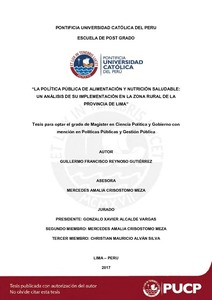| dc.contributor.advisor | Crisóstomo Meza, Mercedes Amalia | |
| dc.contributor.author | Reynoso Gutiérrez, Guillermo Francisco | es_ES |
| dc.date.accessioned | 2017-08-11T00:38:31Z | es_ES |
| dc.date.available | 2017-08-11T00:38:31Z | es_ES |
| dc.date.created | 2017 | es_ES |
| dc.date.issued | 2017-08-11 | es_ES |
| dc.identifier.uri | http://hdl.handle.net/20.500.12404/9208 | |
| dc.description.abstract | El trabajo de investigación tuvo como objetivo principal conocer las dinámicas de la implementación de la política pública de la alimentación y nutrición saludable. Los objetivos específicos estuvieron orientados a definir las características de la Estrategia Sanitaria Nacional de Alimentación y Nutrición Saludable (ESNANS); determinar las dinámicas en su implementación; y analizar las consecuencias de la misma en una zona rural de la provincia de Lima. La hipótesis planteó que la ESNANS es una política de salud pública que ha considerado la pertinencia cultural y el perfil epidemiológico de la población rural de la provincia de Lima. En su implementación se aplicaron mecanismos de coordinación entre las instituciones estales involucradas en el proceso. El trabajo de investigación pudo constatar que la capacidad de gestión del personal del primer nivel de atención fue muy débil debido principalmente al desconocimiento de la Estrategia y a la alta rotación del mismo. Al analizar la Estrategia de Alimentación Saludable en el marco de una política pública, se concluyó que es indispensable establecer una agenda intergubernamental y multisectorial para redefinir el rumbo de las políticas que buscan atender los componentes de sobrepeso, obesidad y hábitos alimenticios. Dichas condiciones pueden ser tan letales como la anemia y la desnutrición crónica, por lo cual constituyen un problema grave para la salud pública. En lo que respecta a la implementación de política pública, la Estrategia de Alimentación Saludable plantea la necesidad de incorporar mecanismos de gestión y coordinación que aborden de manera sistémica la nutrición y alimentación en sus componentes de anemia, desnutrición crónica infantil, sobrepeso y obesidad en toda la población. | es_ES |
| dc.description.abstract | The main objective of the research was to know the dynamics of the implementation of the public policy of food and healthy nutrition. The specific objectives were to define the characteristics of the National Sanitary Strategy of Food and Healthy Nutrition (ESNANS); determine the dynamics in its implementation; and analyze the consequences of it in a rural area of the province of Lima. The hypothesis stated that the ESNANS is a public health policy that has considered the cultural relevance and epidemiological profile of the rural population of the province of Lima. In its implementation, coordination mechanisms were applied among the state institutions involved in the process. The research work showed that the management capacity of the first level of health care was very weak due mainly to the lack of awareness and the high turnover of the Strategy. When analyzing the Healthy Food Strategy in a public policy context, the conclusion was that it is indispensable to establish an intergovernmental and multisectorial agenda to redefine the direction of policies that involved the components of overweight, obesity and eating habits. Such conditions can be as lethal as anemia and chronic malnutrition. Therefore, they constitute a serious public health problem. According to the implementation of public policy, the Healthy Food Strategy raises the need to incorporate management and coordination mechanisms that systematically address nutrition and food in its components of anemia, chronic child malnutrition, overweight and obesity throughout the population. | es_ES |
| dc.language.iso | spa | es_ES |
| dc.publisher | Pontificia Universidad Católica del Perú | es_ES |
| dc.rights | info:eu-repo/semantics/openAccess | es_ES |
| dc.rights.uri | http://creativecommons.org/licenses/by-nc-nd/2.5/pe/ | * |
| dc.subject | Nutrición--Política gubernamental--Perú | es_ES |
| dc.subject | Nutrición--Aspectos sociales--Perú | es_ES |
| dc.subject | Alimentos--Política gubernamental--Perú | es_ES |
| dc.subject | Programas sociales--Perú--Planificación | es_ES |
| dc.subject | Salud pública--Política gubernamental--Perú | es_ES |
| dc.subject | Lima (Perú : Departamento)--Zonas rurales--Nutrición | es_ES |
| dc.title | La política pública de alimentación y nutrición saludable: un análisis de su implementación en la zona rural de la provincia de Lima | es_ES |
| dc.type | info:eu-repo/semantics/masterThesis | es_ES |
| thesis.degree.name | Magíster en Ciencia Política y Gobierno con mención en Políticas Públicas y Gestión Pública | es_ES |
| thesis.degree.level | Maestría | es_ES |
| thesis.degree.grantor | Pontificia Universidad Católica del Perú. Escuela de Posgrado | es_ES |
| thesis.degree.discipline | Ciencia Política y Gobierno con mención en Políticas Públicas y Gestión Pública | es_ES |
| renati.discipline | 312167 | es_ES |
| renati.level | https://purl.org/pe-repo/renati/level#maestro | es_ES |
| renati.type | http://purl.org/pe-repo/renati/type#tesis | es_ES |
| dc.publisher.country | PE | es_ES |
| dc.subject.ocde | https://purl.org/pe-repo/ocde/ford#5.06.00 | es_ES |






